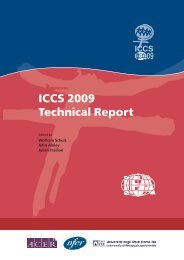Teacher Education and Development Study in Mathematics - IEA
Teacher Education and Development Study in Mathematics - IEA
Teacher Education and Development Study in Mathematics - IEA
Create successful ePaper yourself
Turn your PDF publications into a flip-book with our unique Google optimized e-Paper software.
120<br />
TEACHER PAY AND STUDENT MATHEMATICS ACHIEVEMENT<br />
<strong>Teacher</strong> education<br />
Primary school teachers <strong>in</strong> Mexico traditionally tra<strong>in</strong>ed <strong>in</strong> normal schools, but s<strong>in</strong>ce<br />
the mid 1980s, all primary <strong>and</strong> secondary teachers have been required to obta<strong>in</strong><br />
university-level degrees, from either university or post-secondary normal schools.<br />
Although secondary school teachers generally have university degrees, a 2004 Mexican<br />
employment survey (National Institute of Statistics, Geography, <strong>and</strong> Information,<br />
2004) found that a significant proportion of secondary teachers had not completed a<br />
university qualification.<br />
In 2004, Mexico had 457 teachers’ colleges nationwide, with an enrollment of 169,671<br />
students. Public <strong>in</strong>stitutions enrolled 60% of the students attend<strong>in</strong>g teachers’ colleges <strong>in</strong><br />
2004; the rema<strong>in</strong><strong>in</strong>g 40% of students attended private teachers’ colleges. In 2004, 28%<br />
of students attend<strong>in</strong>g teachers’ colleges were enrolled <strong>in</strong> programs offer<strong>in</strong>g a primary<br />
teach<strong>in</strong>g degree, compared with 39% <strong>in</strong> secondary teach<strong>in</strong>g programs <strong>and</strong> 19% <strong>in</strong><br />
preschool programs (Guevara & González, 2004).<br />
In 1993, Mexico’s M<strong>in</strong>istry of <strong>Education</strong> established the Carerra Magisterial (CM), a new<br />
promotion (<strong>and</strong> pay) system for teachers. The system allows teachers who voluntarily<br />
enter the CM to raise their salaries by a po<strong>in</strong>t system based on exam<strong>in</strong>ations, <strong>in</strong>-service<br />
tra<strong>in</strong><strong>in</strong>g, <strong>and</strong> the performance of their students. By atta<strong>in</strong><strong>in</strong>g CM po<strong>in</strong>ts, teachers can<br />
double their salary while ma<strong>in</strong>ta<strong>in</strong><strong>in</strong>g the same level of experience <strong>and</strong> pre-service<br />
education. This voluntary horizontal promotion arrangement is supposed to reward<br />
teachers who attempt to improve their skills as teachers <strong>and</strong> thereby improve student<br />
performance. Evidence suggests that teachers’ scores on the academic knowledge section<br />
of the CM teacher test correlate significantly <strong>and</strong> positively with student performance,<br />
especially at the secondary school level (Luschei, 2005; Santibañez, 2002). Nevertheless,<br />
the CM is primarily a mechanism for substantially rais<strong>in</strong>g teacher pay by legitimiz<strong>in</strong>g<br />
that <strong>in</strong>crease as part of a teacher-improvement <strong>in</strong>centive program.<br />
Another development <strong>in</strong> the early 1990s (1992/1993) saw the central government<br />
devolv<strong>in</strong>g control of the federal portion of educational spend<strong>in</strong>g <strong>and</strong> school<br />
adm<strong>in</strong>istration to the states. Today, the federal government provides block grants for<br />
education to the states, <strong>and</strong> the states then allocate resources as they see fit to the schools.<br />
Hir<strong>in</strong>g of teachers also became the prov<strong>in</strong>ce of the states, although the teacher union<br />
cont<strong>in</strong>ues to be organized at national level, <strong>and</strong> general salary policies cont<strong>in</strong>ue to be<br />
negotiated nationally. The federal government (via the M<strong>in</strong>istry of <strong>Education</strong>) is still<br />
responsible for national plans, develop<strong>in</strong>g curricula <strong>and</strong> textbooks, develop<strong>in</strong>g materials<br />
for teacher education, <strong>and</strong> evaluat<strong>in</strong>g the national system (<strong>in</strong>clud<strong>in</strong>g <strong>in</strong>dividual state<br />
systems). 15 The federal government also supplies textbooks free to primary students.<br />
15 The federal government established an autonomous evaluation <strong>in</strong>stitution, the Institute for the Evaluation of<br />
<strong>Education</strong>, <strong>in</strong> 2001. However, some states have set up (or are sett<strong>in</strong>g up) local centers that have taken on the task<br />
of develop<strong>in</strong>g programs designed to evaluate school performance.

















